

William Stopford
The cars axed in 2025 that we'll miss the most
15 Hours Ago
The new Hyundai i30 Hybrid is an affordable package that offers exceptional fuel efficiency and TARDIS-like interior space.
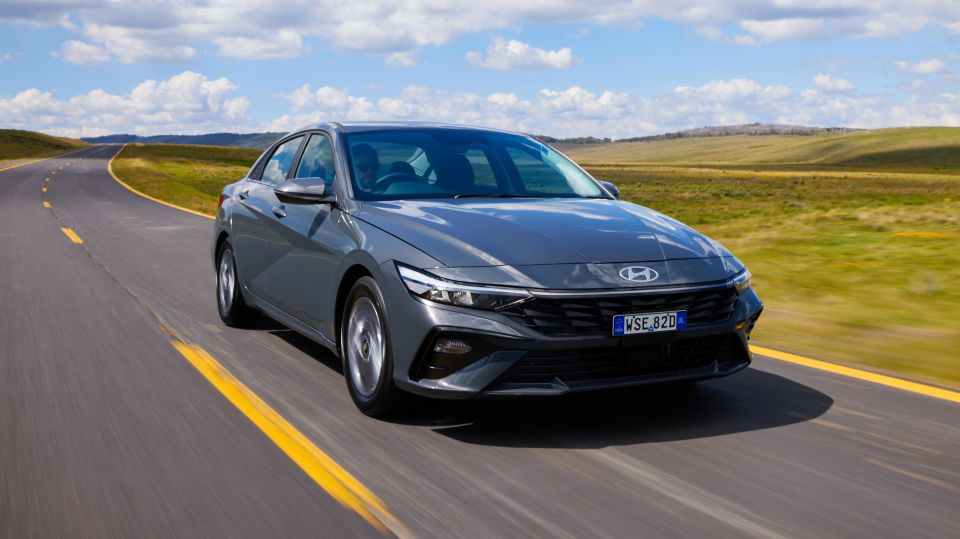
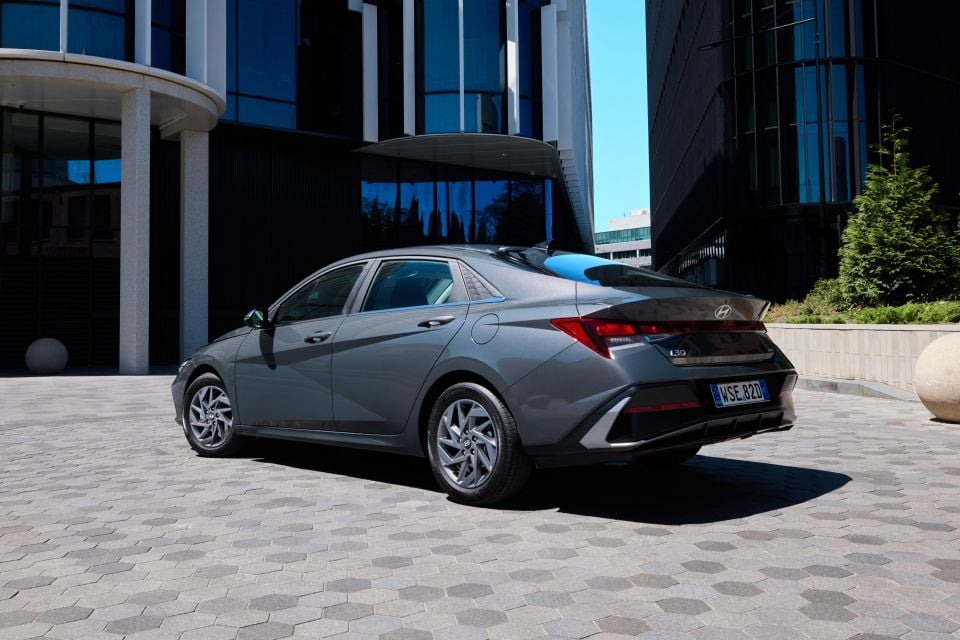

Quickly see how this car stacks up against its competition. Select any benchmark to see more details.
Where expert car reviews meet expert car buying – CarExpert gives you trusted advice, personalised service and real savings on your next new car.
Hyundai is aiming squarely at the fleet-friendly and ultra-efficient Toyota Corolla Hybrid with its new i30 Sedan Hybrid.

This hybrid powertrain has been around in other markets since the current-generation i30 Sedan (known abroad as the Avante and Elantra) first launched in 2020, though it’s only launching locally now with the facelift.
This update has brought refreshed exterior styling including automatic LED headlights with integrated LED daytime running lights, as well as a “deeper and sportier” rear bumper.
Other new features include a revised wireless charging pad for larger phones, front and rear USB-C ports, a customisable multifunction button on the steering wheel, and a revised 4.2-inch instrument cluster on the entry-level variant which is now just called the i30 Sedan (previously called Active).
Speaking of the entry-level model, Hyundai is only offering the entry-level i30 Sedan Hybrid first up. This is what we have on test here. There are i30 Sedan Hybrid Elite and Premium variants coming, but they’re not due until the second quarter of this year.
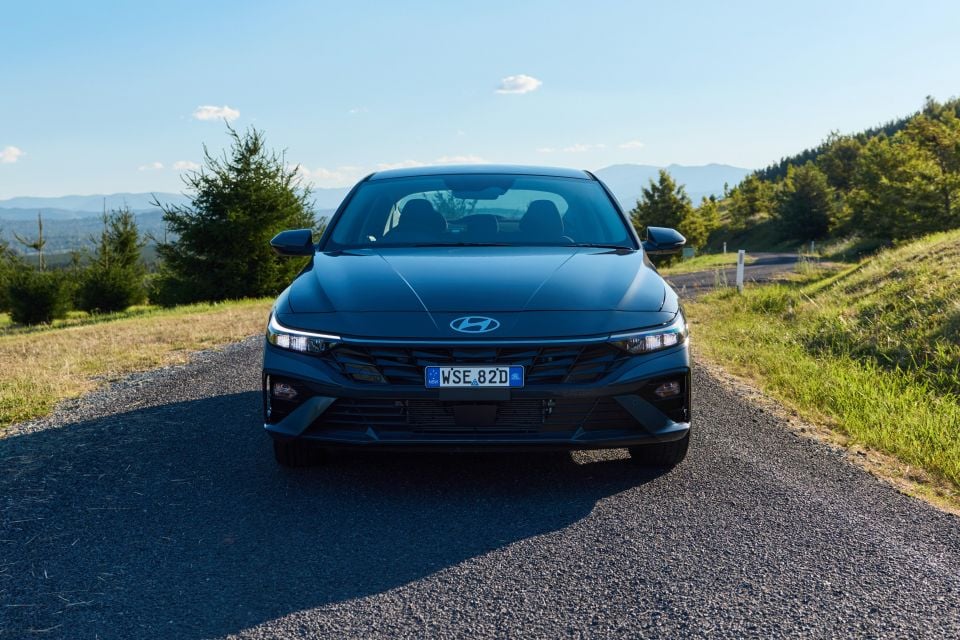
Hyundai i30 Sedan pricing:
Prices are before on-road costs
Hyundai is also currently offering the entry-level i30 Sedan Hybrid on test here for $35,990 drive-away.
To see how the Hyundai i30 compares with its rivals, check out our comparison tool.
Buy your new car without the stress. It's fast, simple and completely free.

Great service from Travis and team, second time I have used this business would not hesitate to recommend them to anyone
Craig C.
Purchased a Ford Ranger in Sunshine Coast, QLD
CarExpert helped Craig save thousands on his Ford Ranger, now let us save you on your next new car.
Find a dealWalking up and hopping into the entry-level Hyundai i30 Sedan Hybrid on test here you need to click the unlock button on the key to unlock the car. The car doesn’t come with proximity entry as standard.
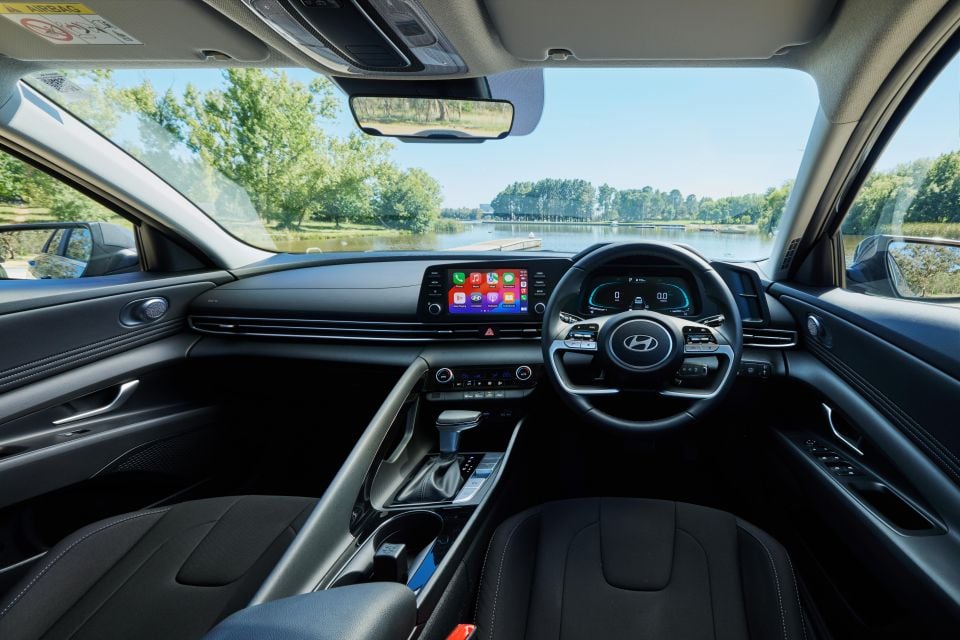
Hopping in you need to step down a little bit further than the likes of the Kona crossover – though this is to be expected.
Something else that take a bit to get used to is where the door handles are located. They are mounted quite low on the door panel and are far away from the seating position, which may make you scratch around looking for them in the dark.
All the seats in the entry-level i30 Sedan Hybrid have black cloth upholstery which is soft to the touch. There’s also an inoffensive design that includes small striped sections on the backrest.
The front seats in particular have a somewhat sporty-looking design with a sculpted appearance. Both the driver and front passenger’s seats are both entirely manually adjustable, but this isn’t the end of the world as once you’ve dialled in your seating position it’s really comfortable.
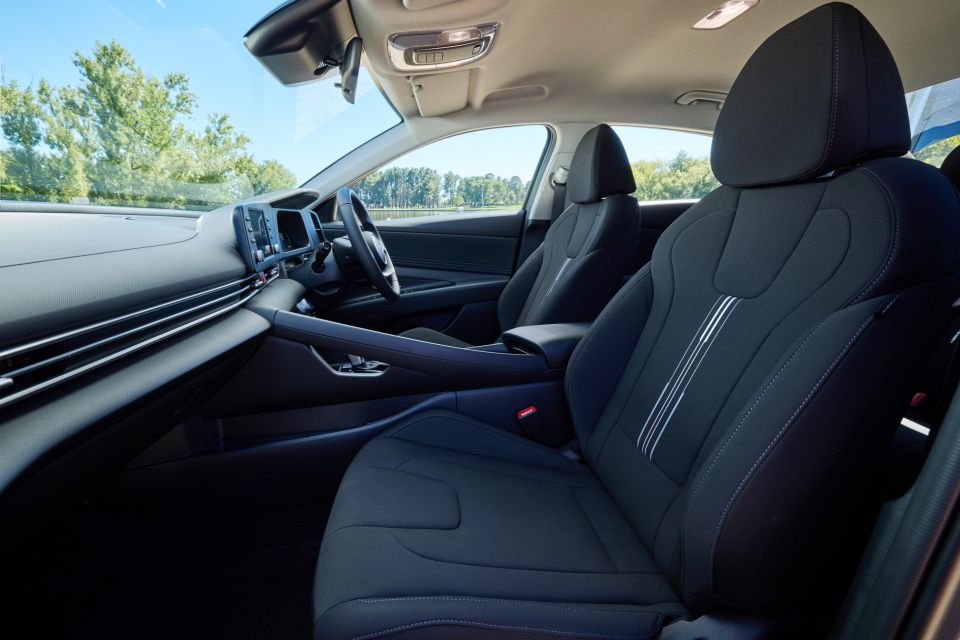
You’re really hugged in by the side bolsters, though thigh support is lacking. It feels like you’re going to slide off the seat if you brake too hard.
Ahead of the driver is a steering wheel that’s thankfully wrapped in buttery soft leather and is nice to hold. There are also some interesting plastic textured elements underneath where your hands sit.
Thankfully all the buttons and switches on the steering wheel are physical ones, and have a satisfyingly clicky action.
Behind the steering wheel is a basic digital instrument cluster that comprises two alarm clock-looking displays for the digital speedometer and revs and a 4.2-inch LCD central display.
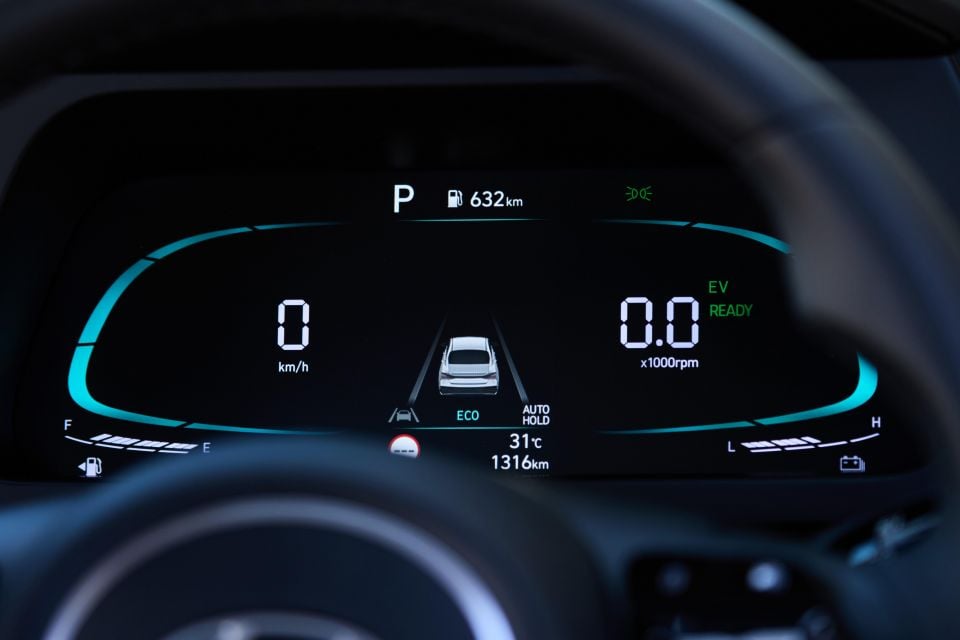
The latter of these displays has a range of different informative pages that show things like the trip meter, fuel economy, adaptive cruise control settings, as well as the energy flow monitor, among others.
Only one informative page can be viewed at a time, which can be a little frustrating at times because you’ll to scroll back and forth between pages to see all your info. This gripe is still present in the proper 10.25-inch digital instrument cluster however.
There are a range of different themes the basic digital instrument cluster can show, which can be dependent on the drive mode selected.
Moving across there’s an 8.0-inch touchscreen infotainment system that verges on the small side, but this is forgivable given it’s the entry-level model. All other variants, besides the entry-level N Line, receive a larger 10.25-inch touchscreen infotainment system.

This 8.0-inch touchscreen in the entry-level i30 Sedan Hybrid is clear and looks high resolution. It also appears to have enough processing power, which means new pages on snappily, though at first it can take a bit to get itself into gear.
The interface is classic Hyundai and is really easy to navigate thanks in part to easy menus and physical shortcut buttons. There’s also a special hybrid informative page in the touchscreen that shows the energy flow monitor, fuel economy, and how hard the electric motor is working.
Like other Hyundai and Kia models with this touchscreen, only wireless forms of both Apple CarPlay and Android Auto are supported. There are USB ports on the centre console that would typically be used for wired smartphone mirroring, but they don’t support that functionality.
Previous Hyundai and Kia models I’ve experienced with this 8.0-inch touchscreen had issues with wireless smartphone mirroring connectivity, however I surprisingly didn’t experience anything like this with the i30 Sedan Hybrid during the local launch.

Thankfully a wireless phone charger is standard across the i30 Sedan range and it actually charged my iPhone 15 Pro Max on longer drives. This is thanks in part to its revised design compared to the pre-update model.
The entry-level i30 Sedan Hybrid doesn’t offer satellite navigation at all, which means it also doesn’t have Hyundai’s Bluelink connected car features. Both of these features are standard on the rest of the i30 Sedan range, apart from the base N Line.
Looking around the cabin there are a fair deal of hard finishes and plastics, which don’t make it look and feel quite as special and premium as its rivals. Thankfully the main touch points, including the door armrests and centre console lid are soft.
This entry-level model doesn’t have as much piano black finishes on the dash and centre console as other variants, but it’s still present around the gear selector and the cupholder section. This gets really dusty and grimy very quickly, and also gets scratched easily from cleaning.
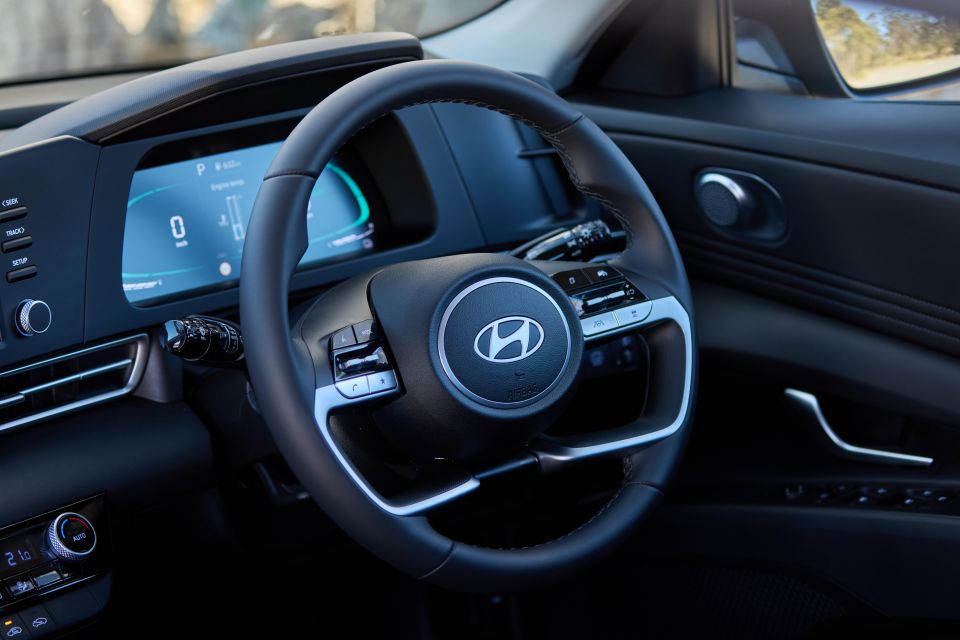
Unlike other variants, the entry-level i30 Sedan Hybrid doesn’t have that strange-looking circle design element on the right-hand side of the digital instrument cluster. Instead there’s a matte black section with contoured cutouts.
The divider between the driver and front passenger has been retained with the update, though it’s still made of rock-hard plastic. Although it didn’t flex and creak, older pre-update examples I’ve previously sampled did this a bit.
A cool feature on the centre console is a switchable cupholder insert that allows for different sized drinks to fit in the spot. This is perfect for those who like tiny coffees.
Moving to the second row, the i30 Sedan Hybrid’s high-voltage battery pack is located underneath the bench seat. Although this means the car’s boot capacity figure remains the same, it has elevated this second-row seating position.

At a leggy 182cm tall my head was brushing the roof when I sat back in the seat properly. Shorter people will be completely fine but taller people may struggle a tad.
Just like the regular i30 Sedan however legroom is fantastic, which is surprising given it’s a small sedan. Two adults fit easily, though having someone sit in the middle seat may make things a touch squishy.
Second-row amenities include rear console-mounted air vents, USB-C ports, a singular map pocket on the back of the front passenger seat, as well as a fold-down armrest with cupholders. There are also the requisite child-seat mounting hardware (ISOFIX and top-tether points).
Moving around the back, the entry-level i30 Sedan Hybrid doesn’t offer a button to open the boot on the boot lid itself. Every other i30 Sedan variant offers this functionality.
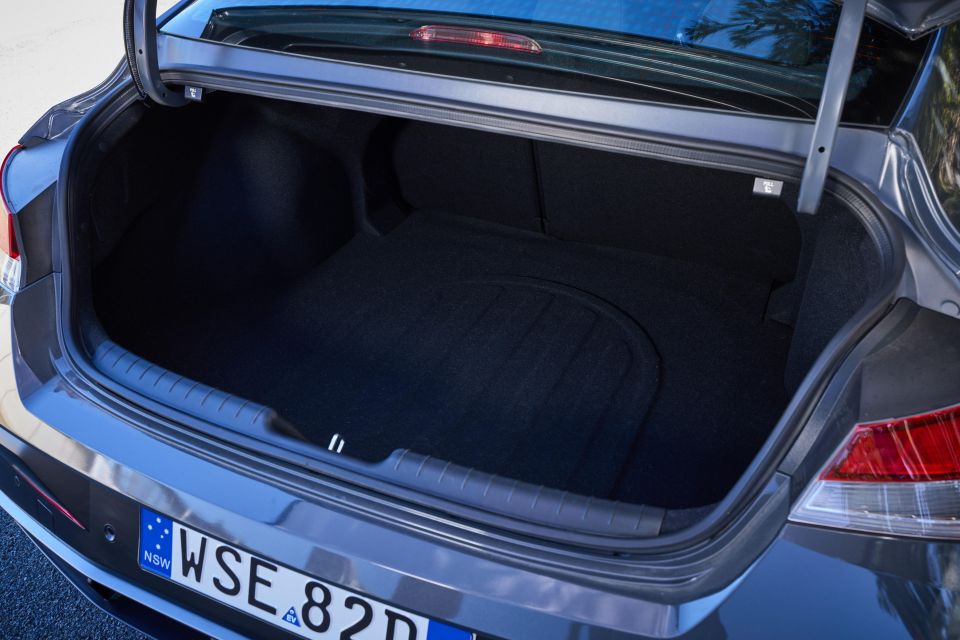
What this means is if you want to open the boot you’ll either need to do this by clicking a button on the key or by flicking the lever on the driver’s side footwell.
Once the boot is open however the space on offer is palatial. Hyundai quotes an official boot capacity figure of 474 litres, which doesn’t sound amazing on paper, but in reality it’s properly deep. One downside that’s inherent to sedans though is the boot opening is a little small.
There really aren’t many feature or notable amenities in the i30 Sedan Hybrid’s boot, which is common among sedans, apart from triggers for folding the rear seats. They fold in a 60/40 split configuration.
Unlike the core i30 Sedan range with the 2.0-litre petrol engine, the i30 Sedan Hybrid comes with a space-saver spare wheel. This isn’t the end of the world but something to keep in mind as you’ll have to travel at a slower speed on the highway and freeway with this tyre fitted in emergencies.
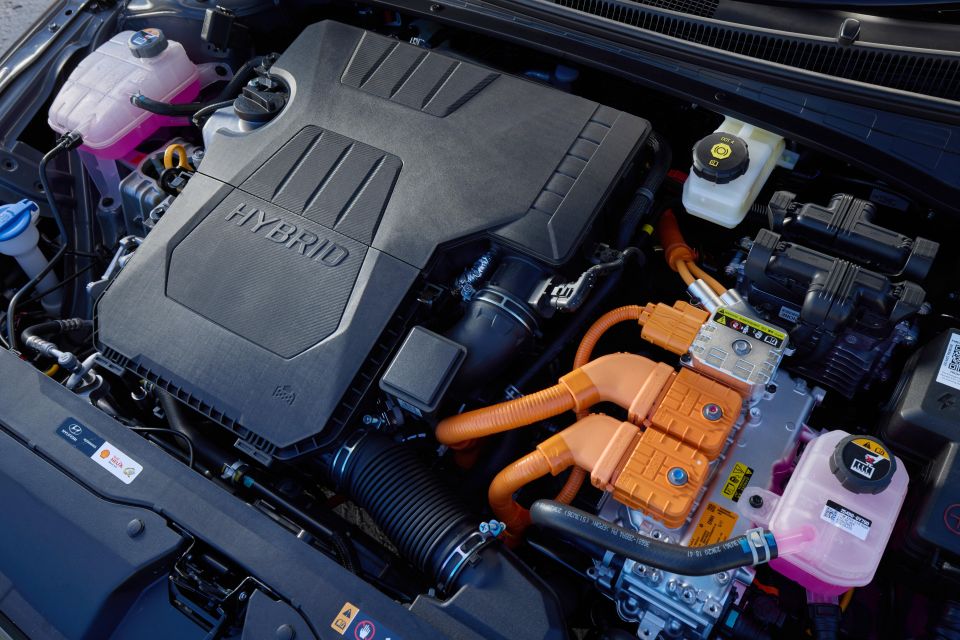
| Model | Hyundai i30 Sedan Hybrid |
|---|---|
| Engine | 1.6-litre 4-cylinder Atkinson cycle petrol engine |
| Engine power | 77kW |
| Engine torque | 147Nm |
| Electric motor | Front-mounted electric motor |
| Electric motor power | 32kW |
| Electric motor torque | 170Nm |
| Total system power | 104kW |
| Total system torque | 265Nm |
| Battery pack | 1.32kWh lithium-ion polymer |
| Driven wheels | Front-wheel drive |
| Weight | 1405kg (kerb) |
| Fuel economy | 3.9L/100km |
| Fuel economy (as tested) | 4.1L/100km (150km mixed rural) |
| Minimum fuel requirement | 91 RON |
The Hyundai i30 Sedan is also available with a 2.0-litre naturally aspirated four-cylinder petrol engine (110kW/180Nm), a 1.6-litre turbocharged four-cylinder petrol engine (150kW/265Nm) in N Line models, and a high-performance 2.0-litre turbocharged four-cylinder petrol engine (206kW/392Nm) in the N.
To see how the Hyundai i30 compares with its rivals, check out our comparison tool.
It’s worth noting straight off the bat we only got to sample the entry-level Hyundai i30 Sedan Hybrid this time at the local media launch.
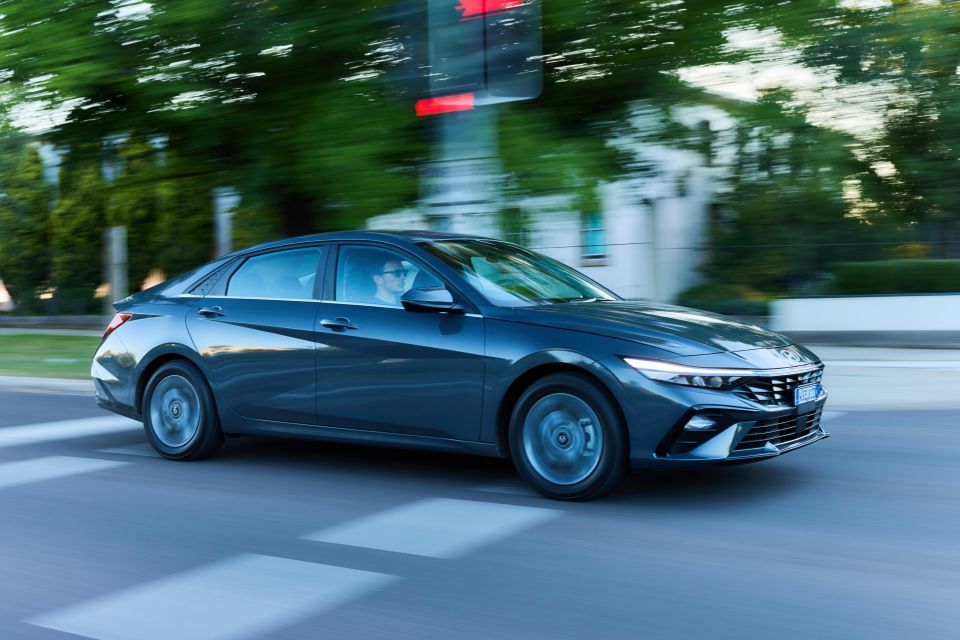
Mid-spec i30 Sedan Hybrid Elite and flagship i30 Sedan Hybrid Premium variants are due in Australia in the second quarter of this year. Pricing and specification for these variants haven’t been confirmed just yet.
Starting up the entry-level i30 Sedan Hybrid you need to you insert the physical key into barrel and turn it. This is incredibly strange to do in a hybrid car because the petrol engine typically doesn’t start up when you turn the key.
What you get instead is some music then a chime to indicate the car is ready to be driven. There’s also a ‘READY’ symbol on the digital instrument cluster that displays.
Setting off in the i30 Sedan Hybrid you’ll will almost always be driving around initially on EV mode, especially in and around the city.

Where expert car reviews meet expert car buying – CarExpert gives you trusted advice, personalised service and real savings on your next new car.
The electric motor is powerful enough for the majority of low speed everyday driving, though it doesn’t feel like it has as much EV-only power as the Corolla Hybrid.
Despite this it’s surprising how far you can travel at low speeds before the petrol engine kicks on. It typically turns on between 20 and 40km/h, but this depends on how much battery charge is remaining.
Speaking of the petrol engine, the i30 Sedan Hybrid’s 1.6-litre four-cylinder unit turns on seamlessly and quietly when required. There’s no lull in power delivery like some hybrid vehicles. A lot of the time you don’t even realise the engine has switched on.
Acceleration in the i30 Sedan Hybrid is decent, but definitely not standout. You’ll be keeping up with cars at the traffic lights no problems, but getting ahead of them is a bit of a struggle.

The petrol engine and electric motor work together well for the most part, but they’re mated with a six-speed dual-clutch automatic transmission that can occasionally make things a little jerky when setting off.
All i30 Sedan Hybrid variants as standard receive a more sophisticated rear multi-link suspension setup. Core models with the 2.0-litre petrol engine on the other hand receive a rear torsion-beam suspension setup.
Adding yet another layer on complexity, the entry-level i30 Sedan Hybrid has a global suspension tune, whereas the forthcoming i30 Sedan Hybrid Elite and Premium are receiving a local suspension tune. To read more on this topic, click here.
Despite having a global suspension tune, the entry-level i30 Sedan Hybrid on test here is still really compliant around town. It deals with pimply roads with no problems whatsoever and even takes on speed bumps like a champ.
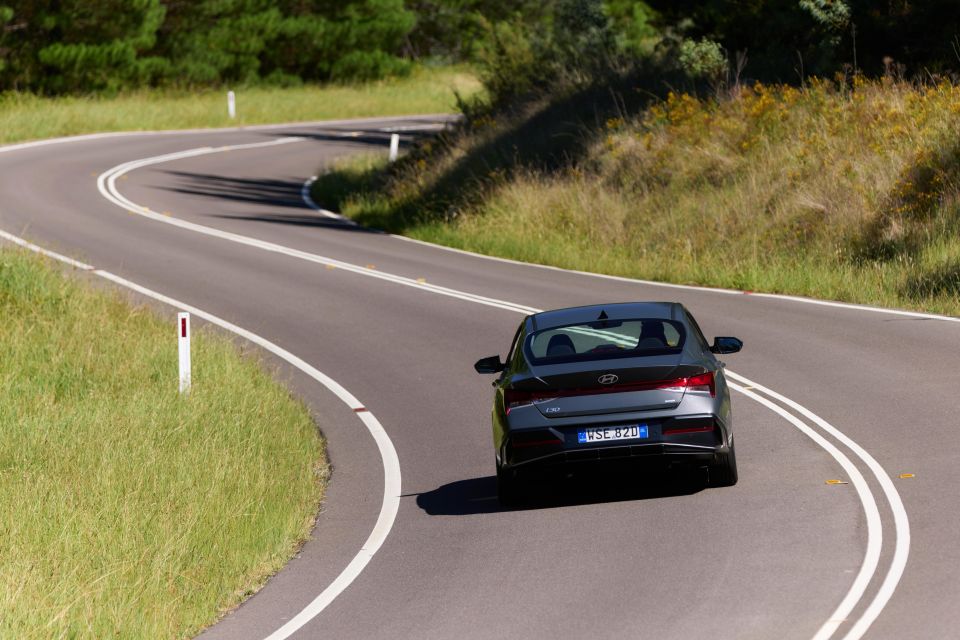
This may also be down to the car coming standard with 16-inch alloy wheels that have plenty of tyre sidewall to soak up bumps.
Like virtually all hybrid cars, there’s a regenerative braking system that besides running the engine is one of the few ways to charge up the high-voltage battery.
When you let out the accelerator while driving there is a small amount of regen braking that is applied – enough to make the car not pick up speed down hills.
By pressing the brake pedal more regen braking is applied, though once you get closer to coming to a stop the physical brakes take over. There thankfully isn’t an an awkward or disjointed handover of braking systems like some hybrids.

Building up speed in the i30 Sedan Hybrid is where things start to come undone. You really need to push the car to get it to accelerate up to highway speeds at a brisk pace.
The petrol engine will more or less stay on constantly at higher speeds, with the occasional boost from the electric motor. If you’re travelling downhill however and there’s enough battery charge, it will switch off the engine and travel for a short period on EV mode.
Once you’re at cruising speeds along highways and freeways, the car will drop back to frequently drop back to fifth gear to maintain the speed. There was a section along the drive loop where I had a headwind which was causing the car to drop back to fifth.
It’ll also drop back to fourth gear on steeper hills, which at 110km/h sees the car rev all the way up to 3500rpm. That’s a bit too high for me, but surprisingly you can’t really hear the engine.
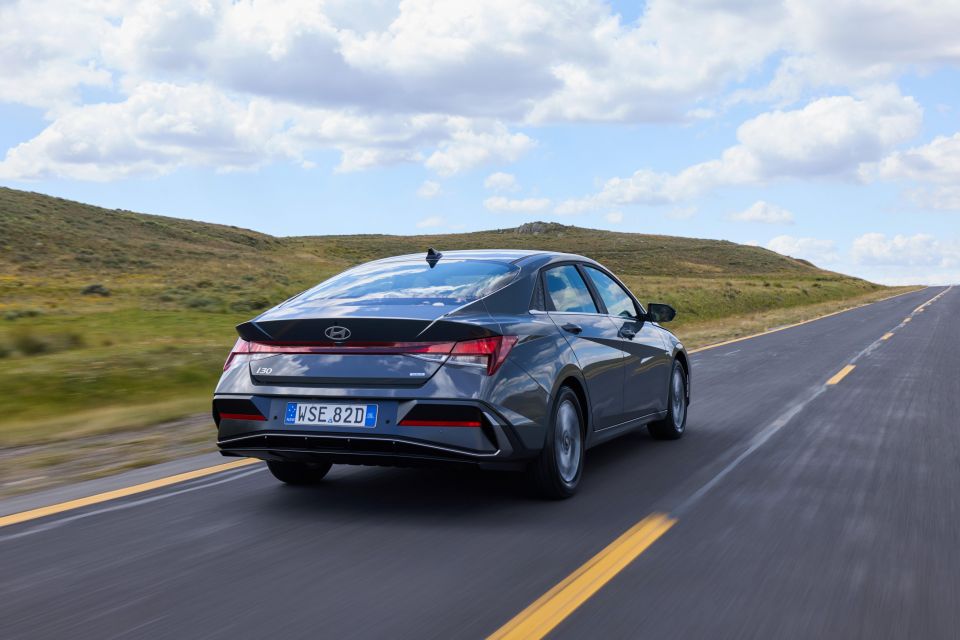
The reason for this is because there’s also a whole heap of road noise that drowns out the engine noise. The side mirrors also seem to create a touch of noticeable wind noise along the freeway.
Despite the hybrid engine not being overly powerful at high speeds, the i30 Sedan Hybrid still feels like it can be driven quickly. We already know the chassis is capable of handling more power, with the i30 Sedan N as evidence.
Like a growing number of Hyundai, Kia and Genesis models, the i30 Sedan Hybrid’s safety systems are a little annoying.
The most annoying and frustrating of the safety systems is the Intelligent Speed Limit Assist function that plays a chime when your surpass the posted speed limit for a certain period.

In theory this system should be really helpful to ensure people don’t speed, but at times the car detects an incorrect speed sign and sounds the chime. This is most notable when travelling through school zones when they aren’t active.
The lane-keep assist function tended to be a bit intrusive, while the Lane Following Assist (lane centring) function can get confused easily. The latter of these systems is best reserved for use on road or highways that are clearly marked.
Lastly, I’m glad even the entry-level i30 Sedan Hybrid comes as standard with LED headlights. This is really helpful when travelling along dark rural and regional roads.
There’s also auto high-beam which means you don’t have to worry about dipping your lights when there’s an oncoming car.


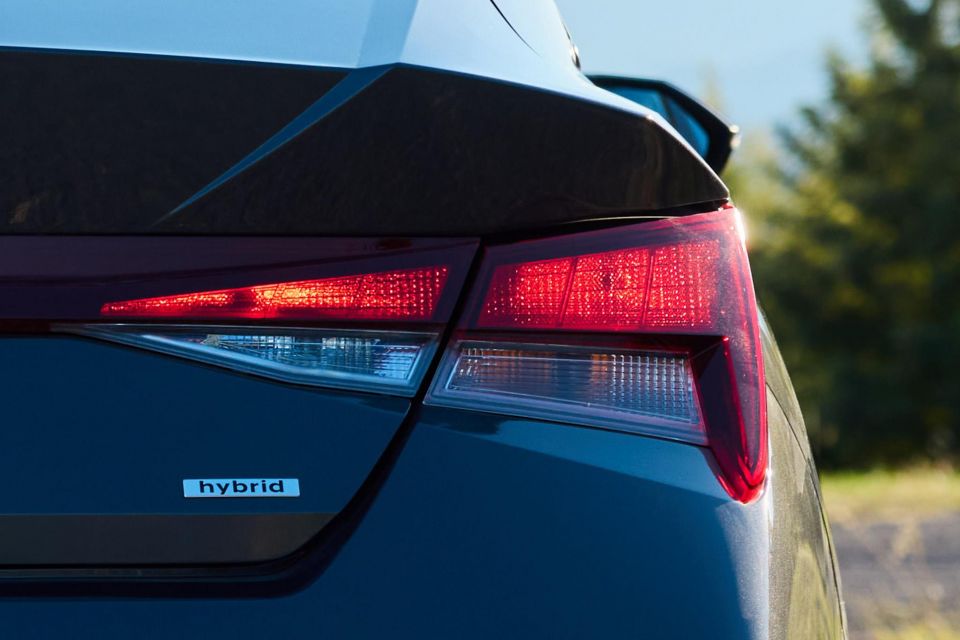

i30 Sedan highlights:
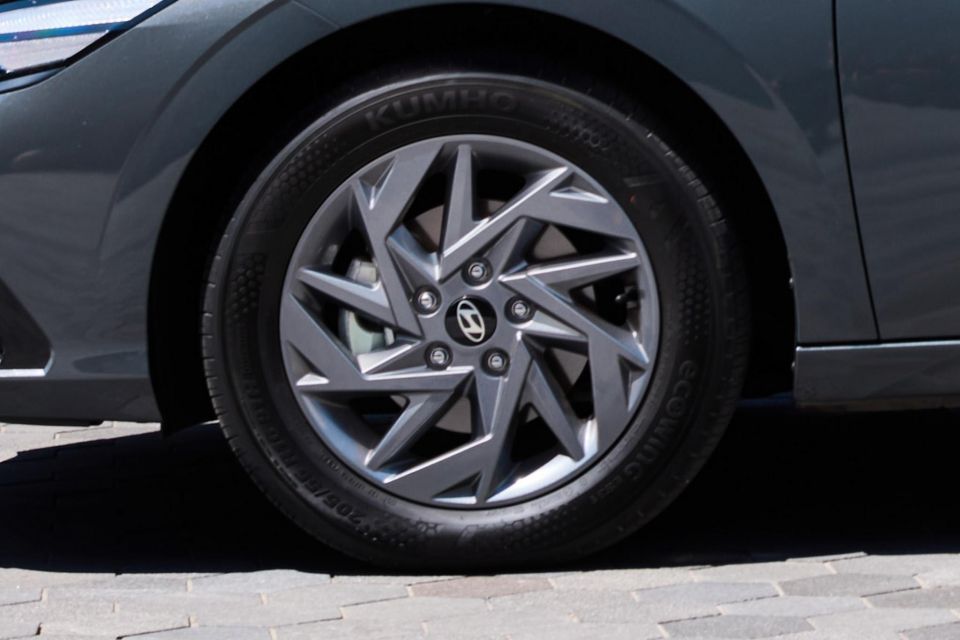

i30 Sedan Elite adds:
i30 Sedan Hybrid Elite specifications to be confirmed closer to launch
i30 Sedan Premium adds:
i30 Sedan Hybrid Premium specifications to be confirmed closer to launch
The Hyundai i30 Sedan has yet to be tested by ANCAP, nor Euro NCAP.
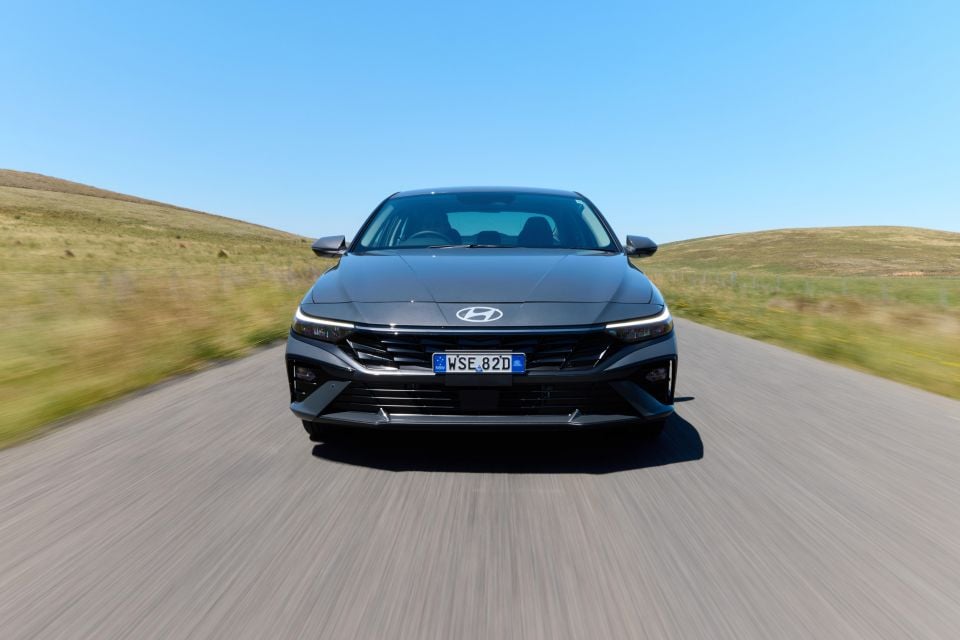
It’s worth noting the US’s IIHS awarded the updated i30 Sedan’s US-market Elantra counterpart a 2023 Top Safety Pick rating.
Standard safety equipment includes:
i30 Sedan Elite adds:
i30 Sedan Premium, N Line Premium adds:
The Hyundai i30 Sedan Hybrid is backed by a five-year, unlimited-kilometre warranty. The high-voltage battery on the other hand is covered by an eight-year/160,000km warranty.

Logbook servicing is required every 12 months or 15,000km, whichever comes first.
i30 Sedan Hybrid service pricing:
| Service | Cost |
|---|---|
| 12 months/15,000km | $310 |
| 24 months/30,000km | $410 |
| 36 months/45,000km | $410 |
| 48 months/60,000km | $710 |
| 60 months/75,000km | $310 |
The Hyundai i30 Sedan is already a really efficient car with the regular 2.0-litre petrol engine, but the new hybrid powertrain truly dials this up to 11.
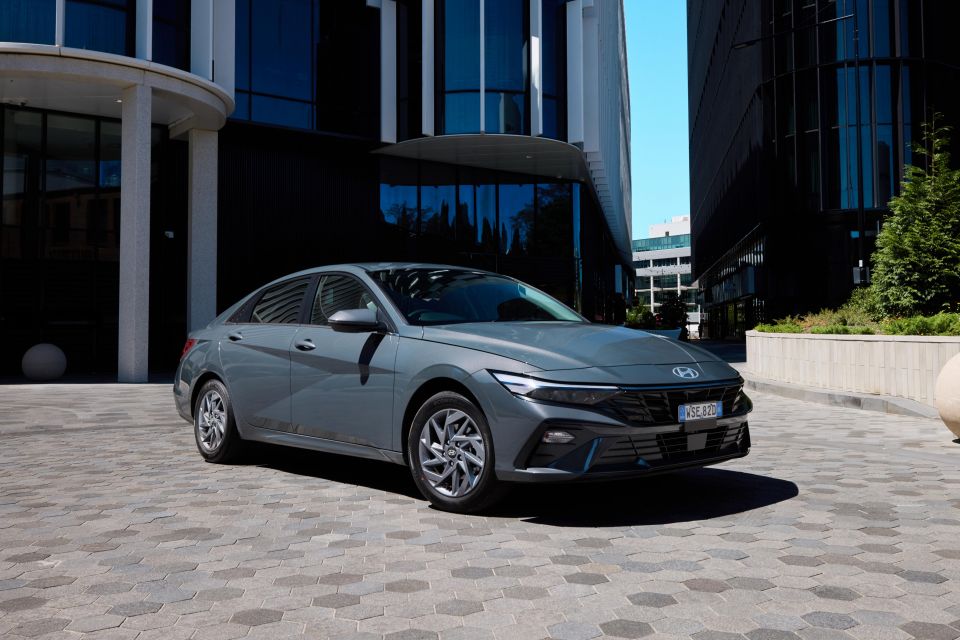
This entry-level i30 Sedan Hybrid variant on test mightn’t be the best reflection of what the car has to offer, but it has a fair bit of standard kit and plenty of second-row and boot space.
I can’t believe it has taken Hyundai this long to introduce the i30 Sedan Hybrid to Australia given it’s been available in other markets since this generation launched in 2020.
It now feels like Hyundai is properly gunning for the Toyota Corolla with the i30 given it now offers the hybrid power. This will be even more so once the new European-sourced i30 Hatch with mild-hybrid power arrives locally mid-year.

Despite this, the fact the Hyundai i30 Sedan hasn’t been crash tested by ANCAP to date really limits the i30 Sedan Hybrid’s potential in the fleet sector. Many companies won’t even consider this car because it doesn’t have a five-star ANCAP safety rating.
For private buyers however, the i30 Sedan Hybrid is an attractive proposition that provides Toyota Corolla Hybrid-rivalling fuel efficiency and pricing.
I’d personally wait to see what the i30 Sedan Hybrid Elite and Premium are priced at and have to offer before jumping at the entry-level model. They’re not too far away.
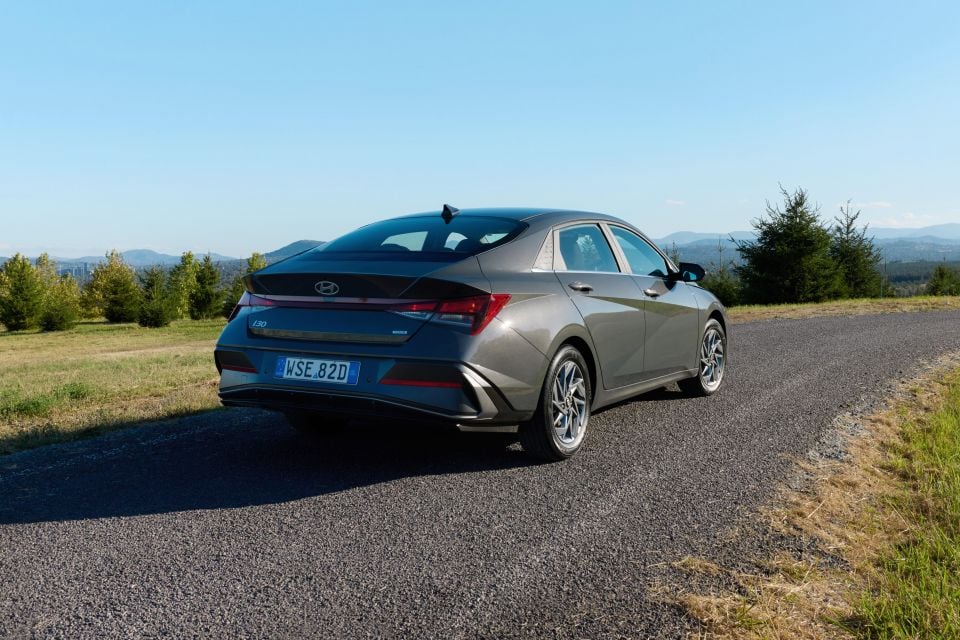
Click the images for the full gallery
BUY: Hyundai i30 MORE: Everything Hyundai i30
Where expert car reviews meet expert car buying – CarExpert gives you trusted advice, personalised service and real savings on your next new car.
Jack Quick is an automotive journalist based in Melbourne. Jack studied journalism and photography at Deakin University in Burwood, and previously represented the university in dance nationally. In his spare time, he loves to pump Charli XCX and play a bit of Grand Theft Auto. He’s also the proud owner of a blue, manual 2020 Suzuki Jimny.


William Stopford
15 Hours Ago


Matt Campbell
23 Hours Ago


William Stopford
2 Days Ago


CarExpert.com.au
5 Days Ago


Max Davies
6 Days Ago


Damion Smy
6 Days Ago